Building and Development Talent Assignment - HR, Topic 3
VerifiedAdded on 2022/11/22
|20
|4909
|482
Homework Assignment
AI Summary
This assignment addresses key aspects of building and developing talent within an organization. It begins by identifying and explaining three career development strategies, emphasizing their benefits for employees. The assignment then delves into job and task analysis, using the example of a Database Administrator to outline required competencies. It further analyzes career stages based on a provided figure, and conducts a training needs analysis (TNA) using the AHRI model. Based on the job/task analysis and TNA, the assignment establishes learning and development program goals and competency requirements, explaining how these meet both organizational and individual needs. Finally, it develops a learning and development plan (LDP), including learning activities designed to build competency and achieve the stated goals. The assignment incorporates feedback from an assessor, highlighting areas for improvement and resubmission.
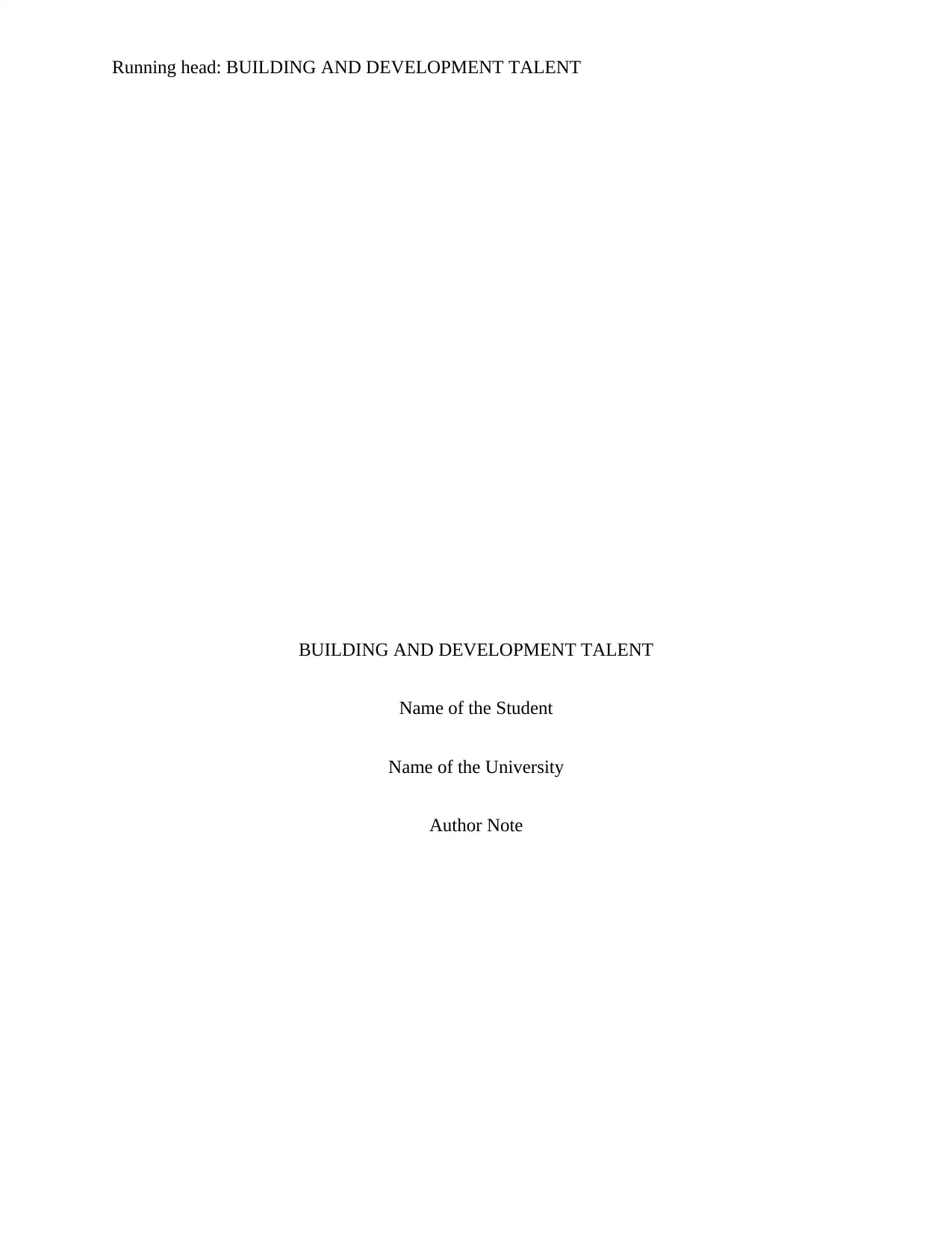
Running head: BUILDING AND DEVELOPMENT TALENT
BUILDING AND DEVELOPMENT TALENT
Name of the Student
Name of the University
Author Note
BUILDING AND DEVELOPMENT TALENT
Name of the Student
Name of the University
Author Note
Paraphrase This Document
Need a fresh take? Get an instant paraphrase of this document with our AI Paraphraser
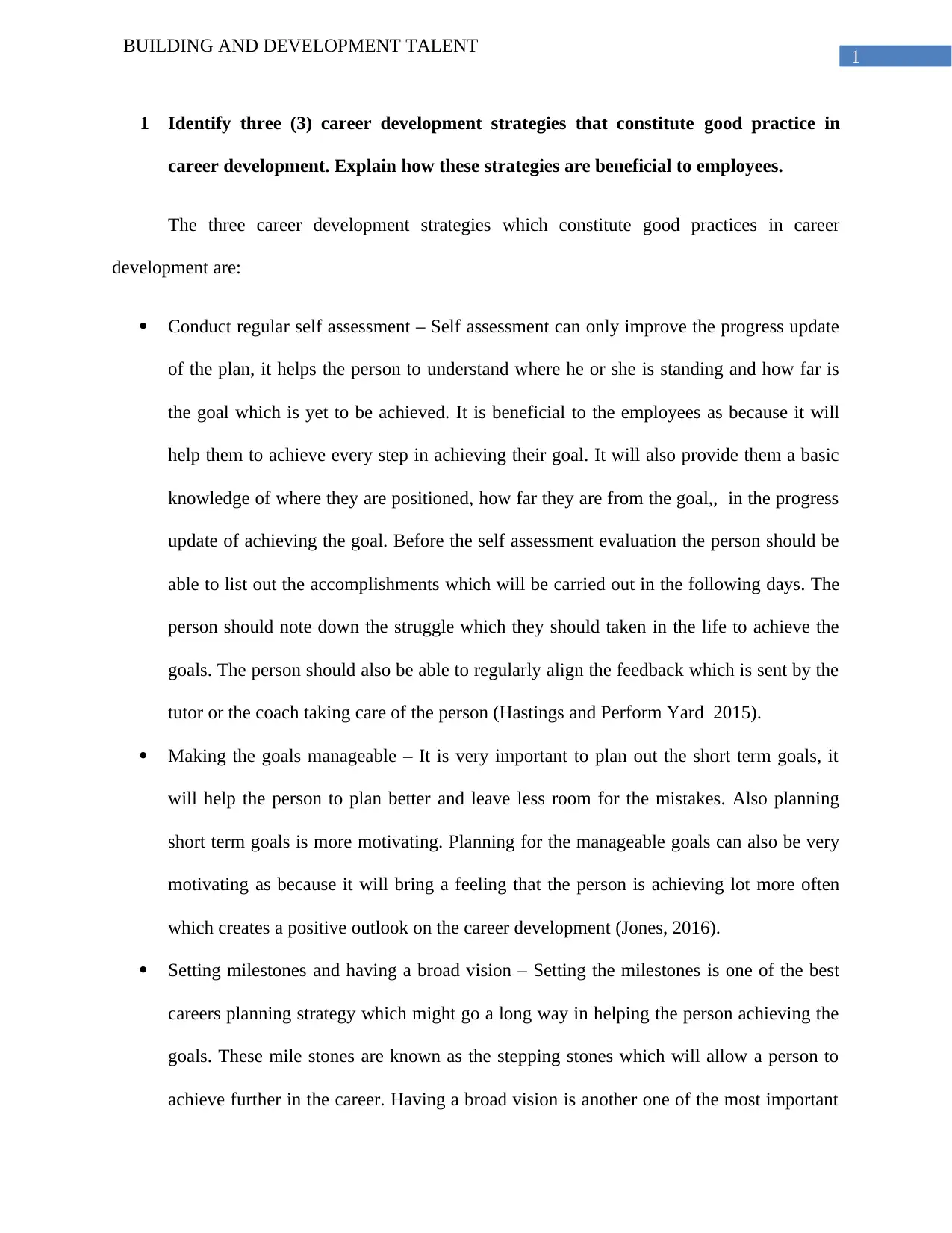
1
BUILDING AND DEVELOPMENT TALENT
1 Identify three (3) career development strategies that constitute good practice in
career development. Explain how these strategies are beneficial to employees.
The three career development strategies which constitute good practices in career
development are:
Conduct regular self assessment – Self assessment can only improve the progress update
of the plan, it helps the person to understand where he or she is standing and how far is
the goal which is yet to be achieved. It is beneficial to the employees as because it will
help them to achieve every step in achieving their goal. It will also provide them a basic
knowledge of where they are positioned, how far they are from the goal,, in the progress
update of achieving the goal. Before the self assessment evaluation the person should be
able to list out the accomplishments which will be carried out in the following days. The
person should note down the struggle which they should taken in the life to achieve the
goals. The person should also be able to regularly align the feedback which is sent by the
tutor or the coach taking care of the person (Hastings and Perform Yard 2015).
Making the goals manageable – It is very important to plan out the short term goals, it
will help the person to plan better and leave less room for the mistakes. Also planning
short term goals is more motivating. Planning for the manageable goals can also be very
motivating as because it will bring a feeling that the person is achieving lot more often
which creates a positive outlook on the career development (Jones, 2016).
Setting milestones and having a broad vision – Setting the milestones is one of the best
careers planning strategy which might go a long way in helping the person achieving the
goals. These mile stones are known as the stepping stones which will allow a person to
achieve further in the career. Having a broad vision is another one of the most important
BUILDING AND DEVELOPMENT TALENT
1 Identify three (3) career development strategies that constitute good practice in
career development. Explain how these strategies are beneficial to employees.
The three career development strategies which constitute good practices in career
development are:
Conduct regular self assessment – Self assessment can only improve the progress update
of the plan, it helps the person to understand where he or she is standing and how far is
the goal which is yet to be achieved. It is beneficial to the employees as because it will
help them to achieve every step in achieving their goal. It will also provide them a basic
knowledge of where they are positioned, how far they are from the goal,, in the progress
update of achieving the goal. Before the self assessment evaluation the person should be
able to list out the accomplishments which will be carried out in the following days. The
person should note down the struggle which they should taken in the life to achieve the
goals. The person should also be able to regularly align the feedback which is sent by the
tutor or the coach taking care of the person (Hastings and Perform Yard 2015).
Making the goals manageable – It is very important to plan out the short term goals, it
will help the person to plan better and leave less room for the mistakes. Also planning
short term goals is more motivating. Planning for the manageable goals can also be very
motivating as because it will bring a feeling that the person is achieving lot more often
which creates a positive outlook on the career development (Jones, 2016).
Setting milestones and having a broad vision – Setting the milestones is one of the best
careers planning strategy which might go a long way in helping the person achieving the
goals. These mile stones are known as the stepping stones which will allow a person to
achieve further in the career. Having a broad vision is another one of the most important

2
BUILDING AND DEVELOPMENT TALENT
career strategy which should be considered in order to visualize and motivate the person.
For example the Olympic athletics have been using the visualization techniques for more
than few years.
2 Conduct job/task analyses for the work team members and identify the competencies
required to do the jobs/tasks. Select one of the job/task analyses to submit for your
response for this question.
A job or task analysis is a process of collecting, analyzing and setting out information about the
content of the job which is required in a particular organization. It therefore helps or provides
information for recruitment, training, job evaluation and performance management. According to
the authors Mone and London (2018) the job ort task analysis concentrates on what job the
holders are expected to do. Whereas the competency analysis is mainly concerned with the
functional analysis which is known to determine the work based competencies and behavioral
analysis. This helps the person to get information regarding the job roles and objectives in a
certain organization (Bernaudin and Dand 2015). The organization’s job roles should match with
the personal characteristics of the individuals which they will bring into the job roles.
The job title which is selected in the context over here is DATABASE ADMINISTRATOR.
The competencies which are required to do the task are described below :
Should be able to analyze and choose options where the accurate technical solution is not
provided. He should also be able to review and evaluate the sources of the IT candidates
who are working in the organization.
BUILDING AND DEVELOPMENT TALENT
career strategy which should be considered in order to visualize and motivate the person.
For example the Olympic athletics have been using the visualization techniques for more
than few years.
2 Conduct job/task analyses for the work team members and identify the competencies
required to do the jobs/tasks. Select one of the job/task analyses to submit for your
response for this question.
A job or task analysis is a process of collecting, analyzing and setting out information about the
content of the job which is required in a particular organization. It therefore helps or provides
information for recruitment, training, job evaluation and performance management. According to
the authors Mone and London (2018) the job ort task analysis concentrates on what job the
holders are expected to do. Whereas the competency analysis is mainly concerned with the
functional analysis which is known to determine the work based competencies and behavioral
analysis. This helps the person to get information regarding the job roles and objectives in a
certain organization (Bernaudin and Dand 2015). The organization’s job roles should match with
the personal characteristics of the individuals which they will bring into the job roles.
The job title which is selected in the context over here is DATABASE ADMINISTRATOR.
The competencies which are required to do the task are described below :
Should be able to analyze and choose options where the accurate technical solution is not
provided. He should also be able to review and evaluate the sources of the IT candidates
who are working in the organization.
⊘ This is a preview!⊘
Do you want full access?
Subscribe today to unlock all pages.

Trusted by 1+ million students worldwide
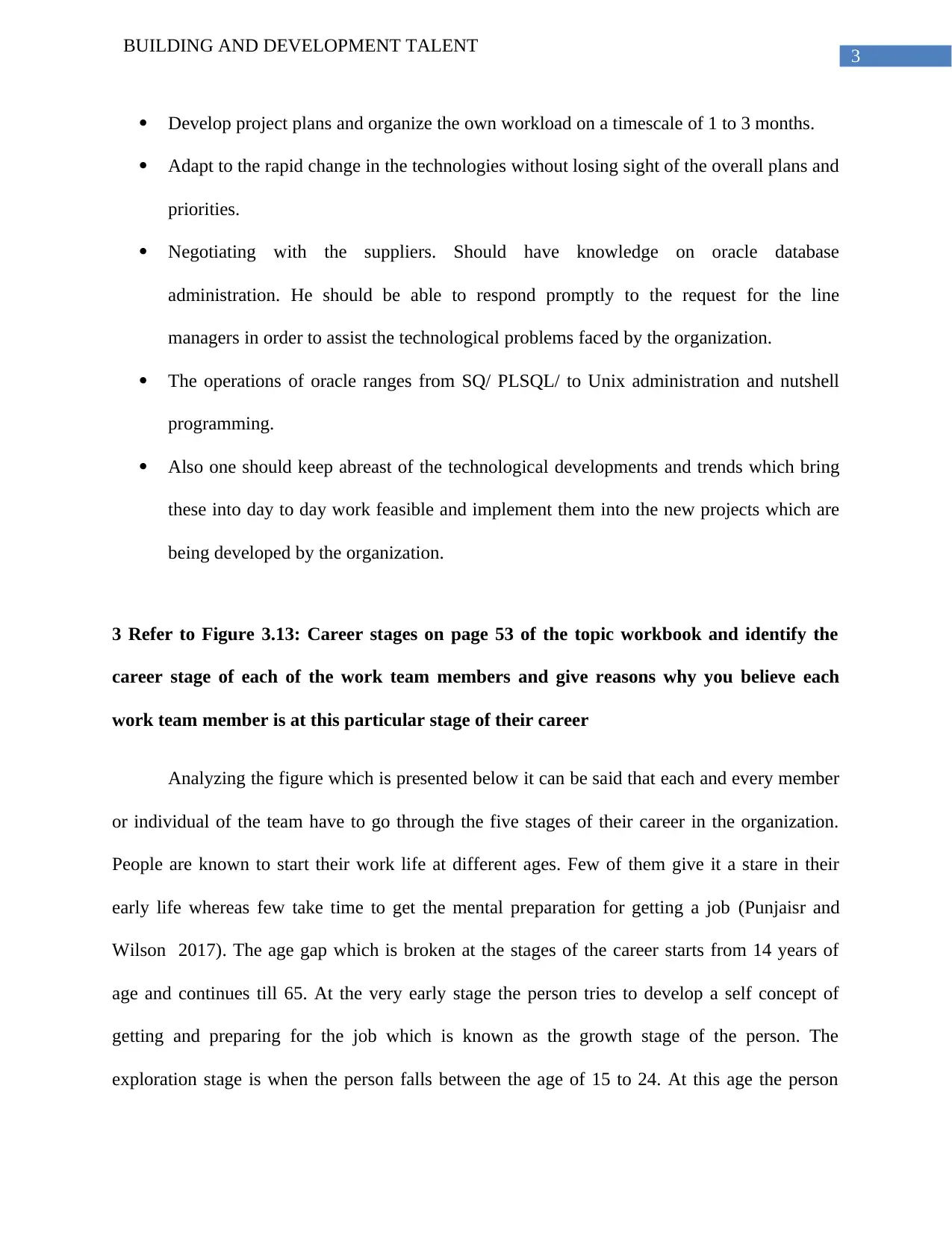
3
BUILDING AND DEVELOPMENT TALENT
Develop project plans and organize the own workload on a timescale of 1 to 3 months.
Adapt to the rapid change in the technologies without losing sight of the overall plans and
priorities.
Negotiating with the suppliers. Should have knowledge on oracle database
administration. He should be able to respond promptly to the request for the line
managers in order to assist the technological problems faced by the organization.
The operations of oracle ranges from SQ/ PLSQL/ to Unix administration and nutshell
programming.
Also one should keep abreast of the technological developments and trends which bring
these into day to day work feasible and implement them into the new projects which are
being developed by the organization.
3 Refer to Figure 3.13: Career stages on page 53 of the topic workbook and identify the
career stage of each of the work team members and give reasons why you believe each
work team member is at this particular stage of their career
Analyzing the figure which is presented below it can be said that each and every member
or individual of the team have to go through the five stages of their career in the organization.
People are known to start their work life at different ages. Few of them give it a stare in their
early life whereas few take time to get the mental preparation for getting a job (Punjaisr and
Wilson 2017). The age gap which is broken at the stages of the career starts from 14 years of
age and continues till 65. At the very early stage the person tries to develop a self concept of
getting and preparing for the job which is known as the growth stage of the person. The
exploration stage is when the person falls between the age of 15 to 24. At this age the person
BUILDING AND DEVELOPMENT TALENT
Develop project plans and organize the own workload on a timescale of 1 to 3 months.
Adapt to the rapid change in the technologies without losing sight of the overall plans and
priorities.
Negotiating with the suppliers. Should have knowledge on oracle database
administration. He should be able to respond promptly to the request for the line
managers in order to assist the technological problems faced by the organization.
The operations of oracle ranges from SQ/ PLSQL/ to Unix administration and nutshell
programming.
Also one should keep abreast of the technological developments and trends which bring
these into day to day work feasible and implement them into the new projects which are
being developed by the organization.
3 Refer to Figure 3.13: Career stages on page 53 of the topic workbook and identify the
career stage of each of the work team members and give reasons why you believe each
work team member is at this particular stage of their career
Analyzing the figure which is presented below it can be said that each and every member
or individual of the team have to go through the five stages of their career in the organization.
People are known to start their work life at different ages. Few of them give it a stare in their
early life whereas few take time to get the mental preparation for getting a job (Punjaisr and
Wilson 2017). The age gap which is broken at the stages of the career starts from 14 years of
age and continues till 65. At the very early stage the person tries to develop a self concept of
getting and preparing for the job which is known as the growth stage of the person. The
exploration stage is when the person falls between the age of 15 to 24. At this age the person
Paraphrase This Document
Need a fresh take? Get an instant paraphrase of this document with our AI Paraphraser
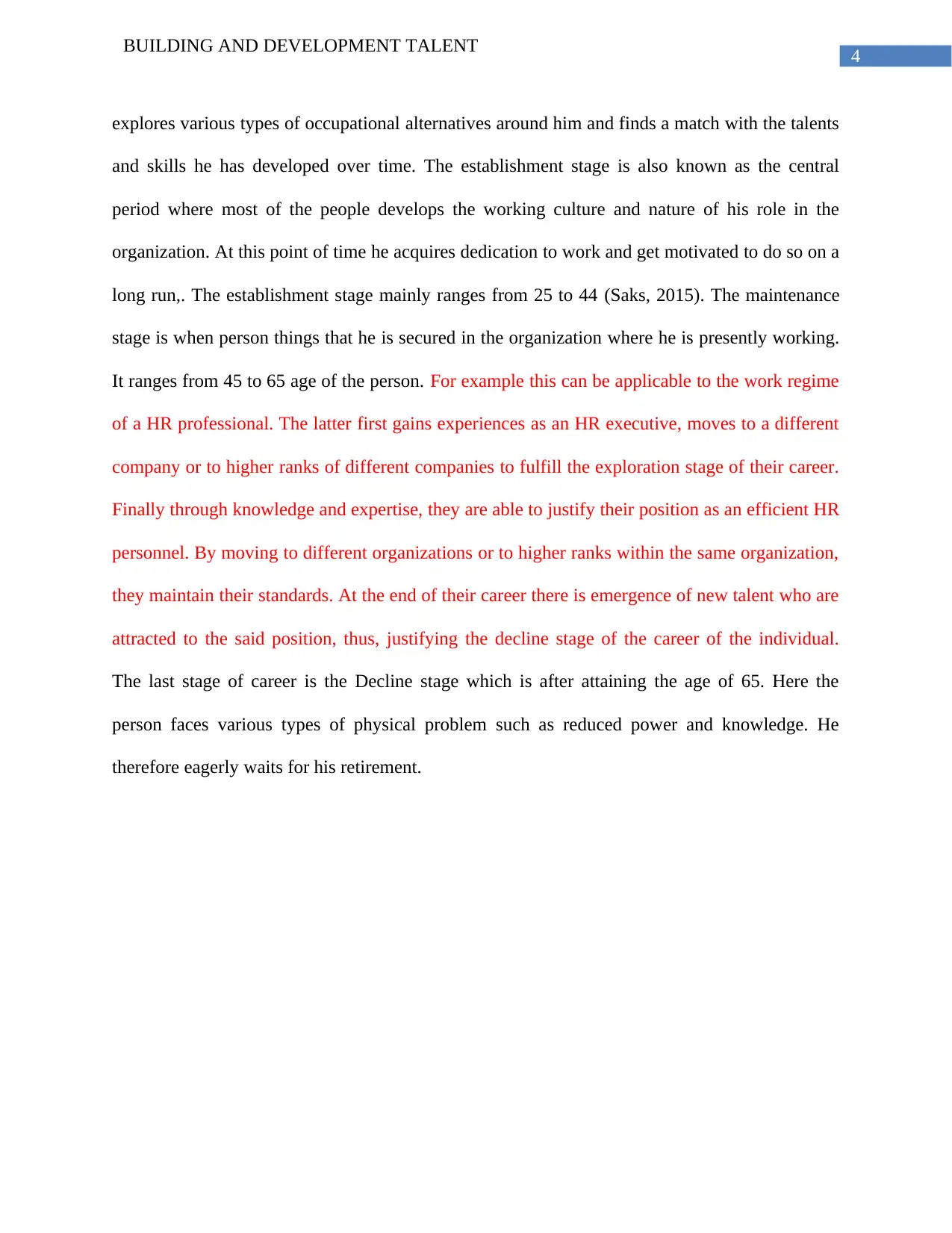
4
BUILDING AND DEVELOPMENT TALENT
explores various types of occupational alternatives around him and finds a match with the talents
and skills he has developed over time. The establishment stage is also known as the central
period where most of the people develops the working culture and nature of his role in the
organization. At this point of time he acquires dedication to work and get motivated to do so on a
long run,. The establishment stage mainly ranges from 25 to 44 (Saks, 2015). The maintenance
stage is when person things that he is secured in the organization where he is presently working.
It ranges from 45 to 65 age of the person. For example this can be applicable to the work regime
of a HR professional. The latter first gains experiences as an HR executive, moves to a different
company or to higher ranks of different companies to fulfill the exploration stage of their career.
Finally through knowledge and expertise, they are able to justify their position as an efficient HR
personnel. By moving to different organizations or to higher ranks within the same organization,
they maintain their standards. At the end of their career there is emergence of new talent who are
attracted to the said position, thus, justifying the decline stage of the career of the individual.
The last stage of career is the Decline stage which is after attaining the age of 65. Here the
person faces various types of physical problem such as reduced power and knowledge. He
therefore eagerly waits for his retirement.
BUILDING AND DEVELOPMENT TALENT
explores various types of occupational alternatives around him and finds a match with the talents
and skills he has developed over time. The establishment stage is also known as the central
period where most of the people develops the working culture and nature of his role in the
organization. At this point of time he acquires dedication to work and get motivated to do so on a
long run,. The establishment stage mainly ranges from 25 to 44 (Saks, 2015). The maintenance
stage is when person things that he is secured in the organization where he is presently working.
It ranges from 45 to 65 age of the person. For example this can be applicable to the work regime
of a HR professional. The latter first gains experiences as an HR executive, moves to a different
company or to higher ranks of different companies to fulfill the exploration stage of their career.
Finally through knowledge and expertise, they are able to justify their position as an efficient HR
personnel. By moving to different organizations or to higher ranks within the same organization,
they maintain their standards. At the end of their career there is emergence of new talent who are
attracted to the said position, thus, justifying the decline stage of the career of the individual.
The last stage of career is the Decline stage which is after attaining the age of 65. Here the
person faces various types of physical problem such as reduced power and knowledge. He
therefore eagerly waits for his retirement.
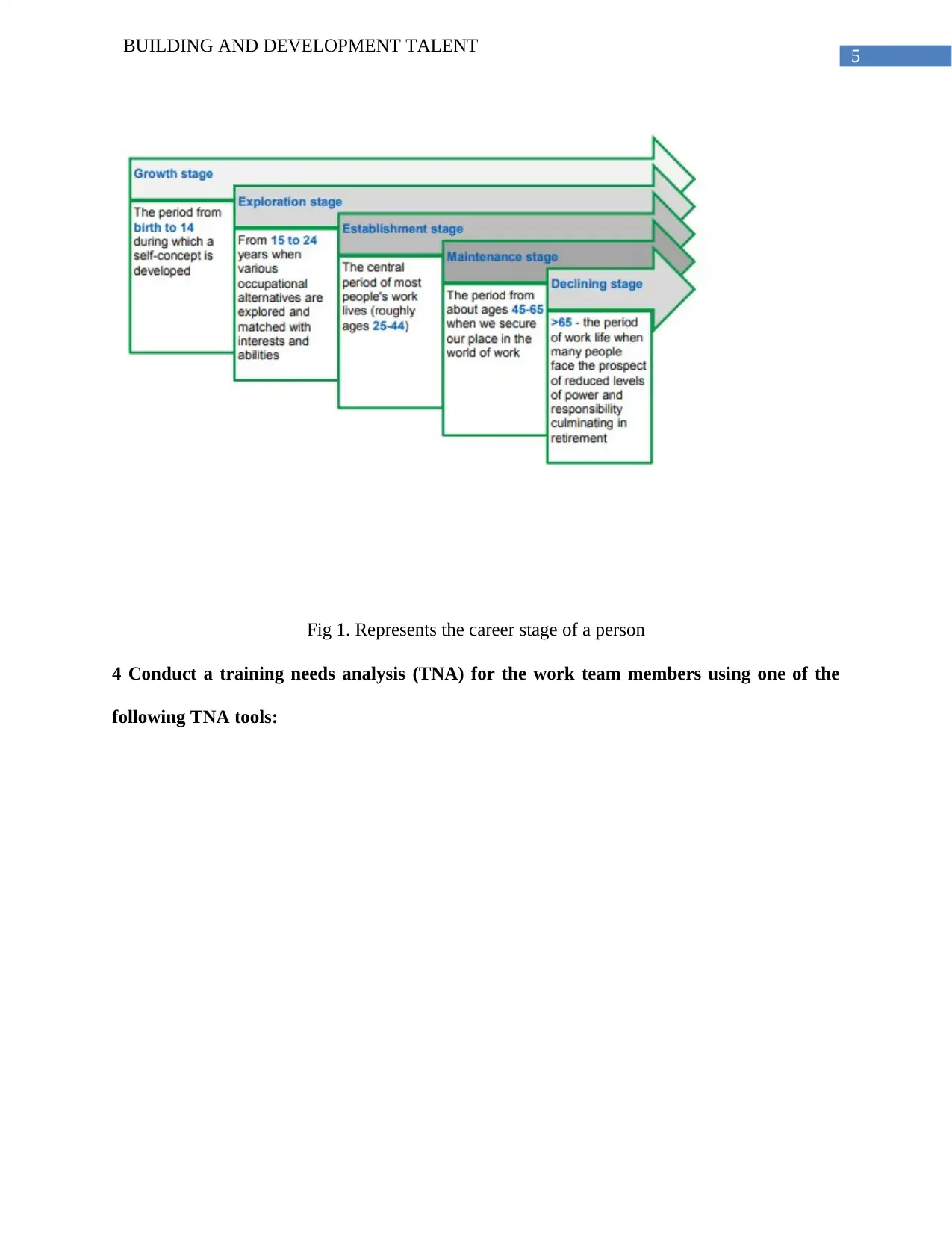
5
BUILDING AND DEVELOPMENT TALENT
Fig 1. Represents the career stage of a person
4 Conduct a training needs analysis (TNA) for the work team members using one of the
following TNA tools:
BUILDING AND DEVELOPMENT TALENT
Fig 1. Represents the career stage of a person
4 Conduct a training needs analysis (TNA) for the work team members using one of the
following TNA tools:
⊘ This is a preview!⊘
Do you want full access?
Subscribe today to unlock all pages.

Trusted by 1+ million students worldwide
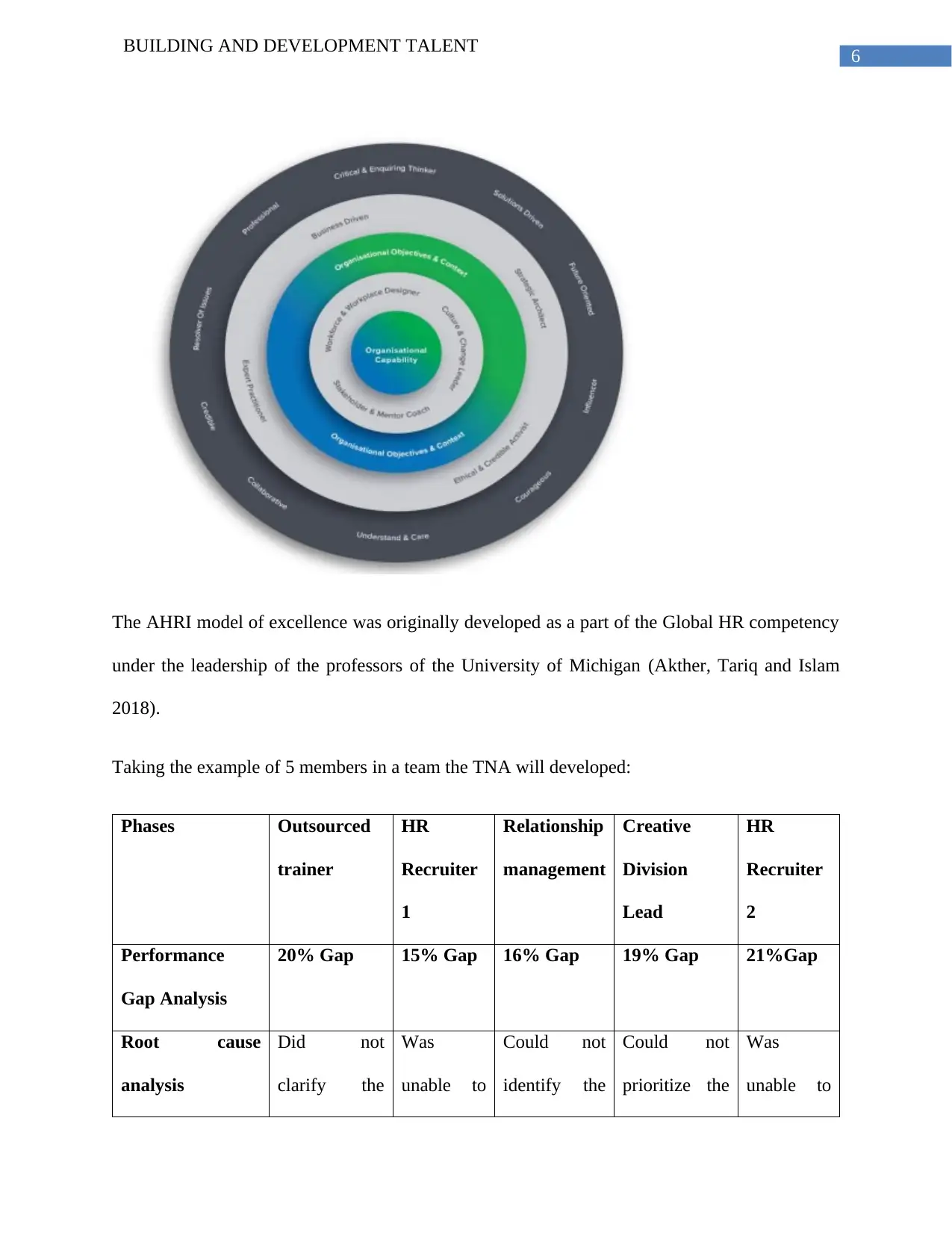
6
BUILDING AND DEVELOPMENT TALENT
The AHRI model of excellence was originally developed as a part of the Global HR competency
under the leadership of the professors of the University of Michigan (Akther, Tariq and Islam
2018).
Taking the example of 5 members in a team the TNA will developed:
Phases Outsourced
trainer
HR
Recruiter
1
Relationship
management
Creative
Division
Lead
HR
Recruiter
2
Performance
Gap Analysis
20% Gap 15% Gap 16% Gap 19% Gap 21%Gap
Root cause
analysis
Did not
clarify the
Was
unable to
Could not
identify the
Could not
prioritize the
Was
unable to
BUILDING AND DEVELOPMENT TALENT
The AHRI model of excellence was originally developed as a part of the Global HR competency
under the leadership of the professors of the University of Michigan (Akther, Tariq and Islam
2018).
Taking the example of 5 members in a team the TNA will developed:
Phases Outsourced
trainer
HR
Recruiter
1
Relationship
management
Creative
Division
Lead
HR
Recruiter
2
Performance
Gap Analysis
20% Gap 15% Gap 16% Gap 19% Gap 21%Gap
Root cause
analysis
Did not
clarify the
Was
unable to
Could not
identify the
Could not
prioritize the
Was
unable to
Paraphrase This Document
Need a fresh take? Get an instant paraphrase of this document with our AI Paraphraser

7
BUILDING AND DEVELOPMENT TALENT
learning
objectives
and outcomes
determine
the
necessary
skills and
knowledge
performance
behavior
organizational
goals
determine
the
necessary
skills and
knowledge
Need Analysis Should
determine the
business
outcomes
Should be
able to link
the
training
needs with
the goals
Should be
able to
determine
performance
gaps
Should be
able to
prioritize the
needs
Should be
able to link
the
training
needs with
the goals
Recommendatio
n
Should be
able to
establish
organization’s
specific goals
Should
outline the
future plan
Should
utilize the
internal
technological
knowledge
Should be
able to
establish
organization’s
specific goals
Should
outline the
future plan
5 Based on Part 1 findings (i.e. the job task analysis and TNA report for Questions 2 & 4):
• Identify learning and development program goals and competency requirements; and
• Explain how these goals meet both the organisation’s needs and the individual’s needs
BUILDING AND DEVELOPMENT TALENT
learning
objectives
and outcomes
determine
the
necessary
skills and
knowledge
performance
behavior
organizational
goals
determine
the
necessary
skills and
knowledge
Need Analysis Should
determine the
business
outcomes
Should be
able to link
the
training
needs with
the goals
Should be
able to
determine
performance
gaps
Should be
able to
prioritize the
needs
Should be
able to link
the
training
needs with
the goals
Recommendatio
n
Should be
able to
establish
organization’s
specific goals
Should
outline the
future plan
Should
utilize the
internal
technological
knowledge
Should be
able to
establish
organization’s
specific goals
Should
outline the
future plan
5 Based on Part 1 findings (i.e. the job task analysis and TNA report for Questions 2 & 4):
• Identify learning and development program goals and competency requirements; and
• Explain how these goals meet both the organisation’s needs and the individual’s needs
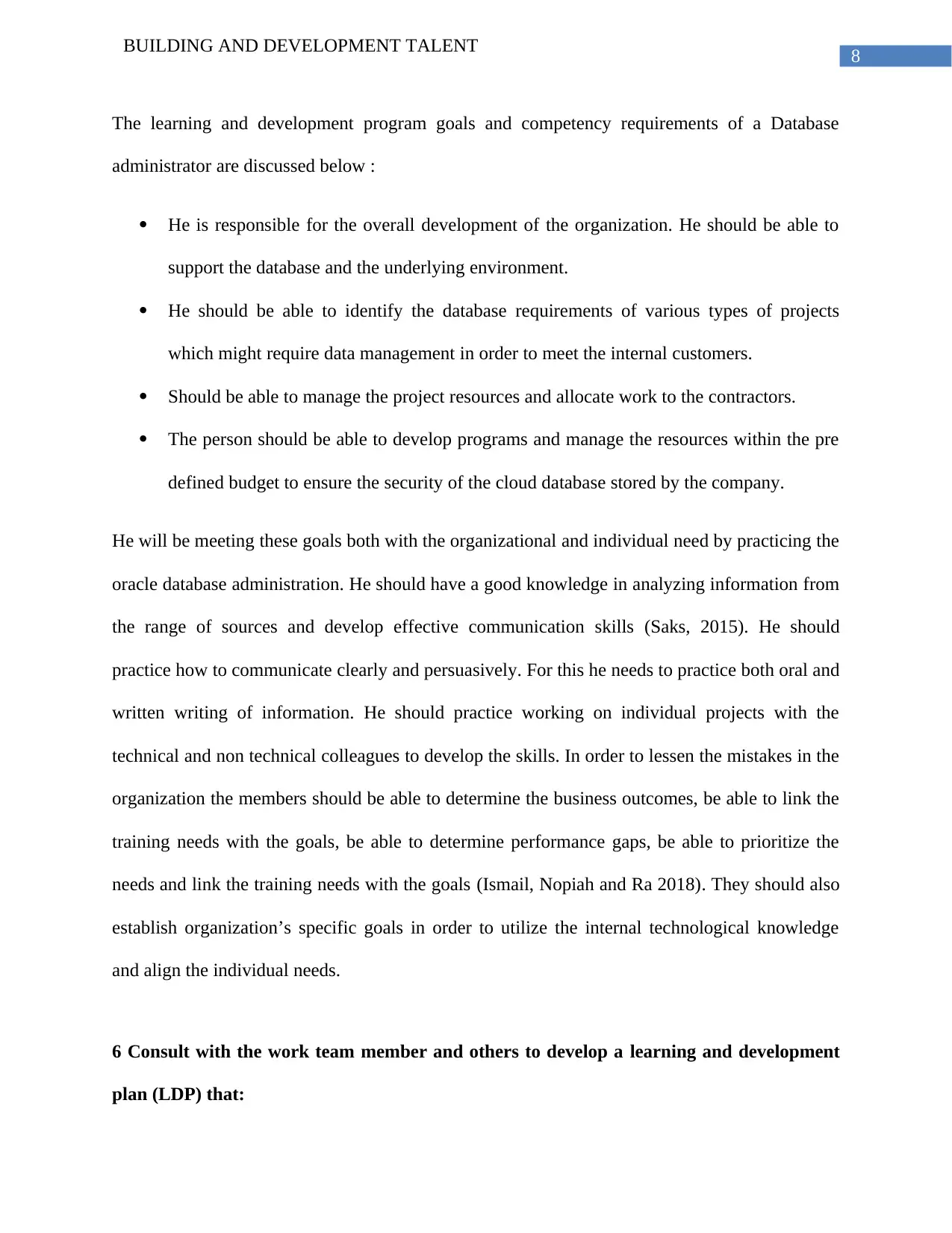
8
BUILDING AND DEVELOPMENT TALENT
The learning and development program goals and competency requirements of a Database
administrator are discussed below :
He is responsible for the overall development of the organization. He should be able to
support the database and the underlying environment.
He should be able to identify the database requirements of various types of projects
which might require data management in order to meet the internal customers.
Should be able to manage the project resources and allocate work to the contractors.
The person should be able to develop programs and manage the resources within the pre
defined budget to ensure the security of the cloud database stored by the company.
He will be meeting these goals both with the organizational and individual need by practicing the
oracle database administration. He should have a good knowledge in analyzing information from
the range of sources and develop effective communication skills (Saks, 2015). He should
practice how to communicate clearly and persuasively. For this he needs to practice both oral and
written writing of information. He should practice working on individual projects with the
technical and non technical colleagues to develop the skills. In order to lessen the mistakes in the
organization the members should be able to determine the business outcomes, be able to link the
training needs with the goals, be able to determine performance gaps, be able to prioritize the
needs and link the training needs with the goals (Ismail, Nopiah and Ra 2018). They should also
establish organization’s specific goals in order to utilize the internal technological knowledge
and align the individual needs.
6 Consult with the work team member and others to develop a learning and development
plan (LDP) that:
BUILDING AND DEVELOPMENT TALENT
The learning and development program goals and competency requirements of a Database
administrator are discussed below :
He is responsible for the overall development of the organization. He should be able to
support the database and the underlying environment.
He should be able to identify the database requirements of various types of projects
which might require data management in order to meet the internal customers.
Should be able to manage the project resources and allocate work to the contractors.
The person should be able to develop programs and manage the resources within the pre
defined budget to ensure the security of the cloud database stored by the company.
He will be meeting these goals both with the organizational and individual need by practicing the
oracle database administration. He should have a good knowledge in analyzing information from
the range of sources and develop effective communication skills (Saks, 2015). He should
practice how to communicate clearly and persuasively. For this he needs to practice both oral and
written writing of information. He should practice working on individual projects with the
technical and non technical colleagues to develop the skills. In order to lessen the mistakes in the
organization the members should be able to determine the business outcomes, be able to link the
training needs with the goals, be able to determine performance gaps, be able to prioritize the
needs and link the training needs with the goals (Ismail, Nopiah and Ra 2018). They should also
establish organization’s specific goals in order to utilize the internal technological knowledge
and align the individual needs.
6 Consult with the work team member and others to develop a learning and development
plan (LDP) that:
⊘ This is a preview!⊘
Do you want full access?
Subscribe today to unlock all pages.

Trusted by 1+ million students worldwide

9
BUILDING AND DEVELOPMENT TALENT
• includes appropriate learning and development activities; and
• is designed to build competency and achieve the learning and development goals.
Speak to the trainee and members present in the team to determine the progress update to the
performance shortfalls and discuss their strengths. The meeting will discuss the learning development
tools which should be used as soon as possible to defuse a potential tense situation of the trainee.
Environment
Meeting the members in a private room where there is no interruption, no distraction is very important.
Attitude of the Training supervisor
Provide supportive guidance which should be confidentially assured, receptive to trainee input, The
focus of the trainer should be focused on the training improvement of the member.
Creating an atmosphere of trust will help feel the member is safe to discuss his own deficiencies.
Emphasize that the aim of the aim of the Learning Development Plan is to support the member in
making improvements.
Discussion Point
The main point of this part is to discuss the reasons of underperformance of the employee and design
learning / training pathway to meet the results in improved performance. Should be able to
acknowledge the and good performance areas. Cite specific examples of areas of underperformance.
Avoid generalities. Very specific examples will be particularly necessary when meeting with trainees who
may lack insight and are resistant to suggestions that there are areas for improvement.
Learning and Development Plan
BUILDING AND DEVELOPMENT TALENT
• includes appropriate learning and development activities; and
• is designed to build competency and achieve the learning and development goals.
Speak to the trainee and members present in the team to determine the progress update to the
performance shortfalls and discuss their strengths. The meeting will discuss the learning development
tools which should be used as soon as possible to defuse a potential tense situation of the trainee.
Environment
Meeting the members in a private room where there is no interruption, no distraction is very important.
Attitude of the Training supervisor
Provide supportive guidance which should be confidentially assured, receptive to trainee input, The
focus of the trainer should be focused on the training improvement of the member.
Creating an atmosphere of trust will help feel the member is safe to discuss his own deficiencies.
Emphasize that the aim of the aim of the Learning Development Plan is to support the member in
making improvements.
Discussion Point
The main point of this part is to discuss the reasons of underperformance of the employee and design
learning / training pathway to meet the results in improved performance. Should be able to
acknowledge the and good performance areas. Cite specific examples of areas of underperformance.
Avoid generalities. Very specific examples will be particularly necessary when meeting with trainees who
may lack insight and are resistant to suggestions that there are areas for improvement.
Learning and Development Plan
Paraphrase This Document
Need a fresh take? Get an instant paraphrase of this document with our AI Paraphraser

10
BUILDING AND DEVELOPMENT TALENT
7 In designing the Learning and Development Plan for the work team member explain:
• Who you have or who you would consult with to develop the LDP and obtain commitment
to career development
In order to develop the Learning and Development Plan I have to consult with the team leader of
the specific department where the members are working with. Further I have to consult with the
tutor who is taking care of the members and providing them training and development. Further in
order to process the Learning and Development Plan I have to take the help of the tutor to
analyze the under performance of the employee and detect the gap from each other members in
the team. Apart from help from the part of the tutor there is help that would be required from the
part of the Human Resource Team and the senior management of the team. The latter would
have a good understanding about the flow of operations within the organization and hence their
involvement would be valued.
• What HR policies and procedures you referred to/used to develop both individuals and
work teams
BUILDING AND DEVELOPMENT TALENT
7 In designing the Learning and Development Plan for the work team member explain:
• Who you have or who you would consult with to develop the LDP and obtain commitment
to career development
In order to develop the Learning and Development Plan I have to consult with the team leader of
the specific department where the members are working with. Further I have to consult with the
tutor who is taking care of the members and providing them training and development. Further in
order to process the Learning and Development Plan I have to take the help of the tutor to
analyze the under performance of the employee and detect the gap from each other members in
the team. Apart from help from the part of the tutor there is help that would be required from the
part of the Human Resource Team and the senior management of the team. The latter would
have a good understanding about the flow of operations within the organization and hence their
involvement would be valued.
• What HR policies and procedures you referred to/used to develop both individuals and
work teams
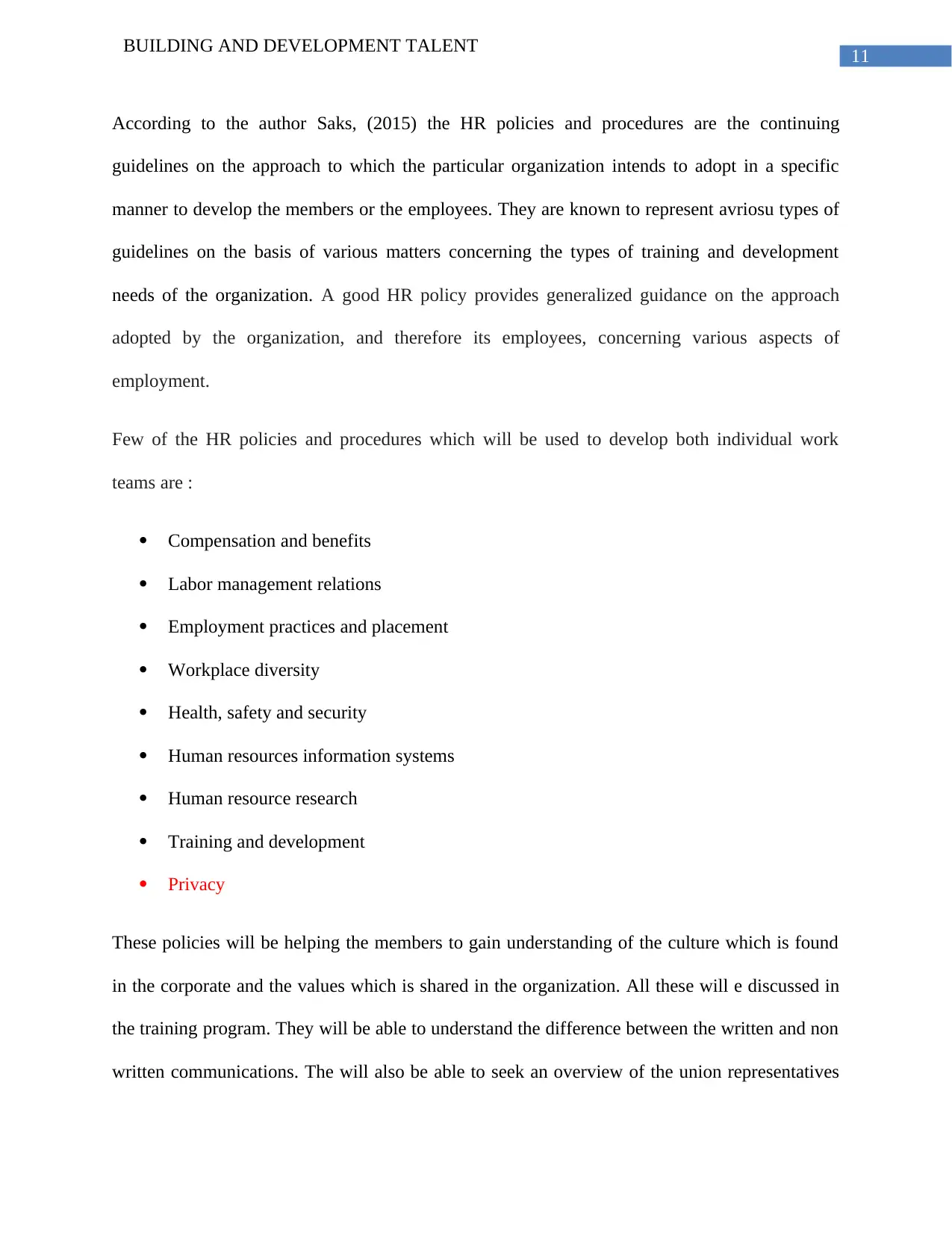
11
BUILDING AND DEVELOPMENT TALENT
According to the author Saks, (2015) the HR policies and procedures are the continuing
guidelines on the approach to which the particular organization intends to adopt in a specific
manner to develop the members or the employees. They are known to represent avriosu types of
guidelines on the basis of various matters concerning the types of training and development
needs of the organization. A good HR policy provides generalized guidance on the approach
adopted by the organization, and therefore its employees, concerning various aspects of
employment.
Few of the HR policies and procedures which will be used to develop both individual work
teams are :
Compensation and benefits
Labor management relations
Employment practices and placement
Workplace diversity
Health, safety and security
Human resources information systems
Human resource research
Training and development
Privacy
These policies will be helping the members to gain understanding of the culture which is found
in the corporate and the values which is shared in the organization. All these will e discussed in
the training program. They will be able to understand the difference between the written and non
written communications. The will also be able to seek an overview of the union representatives
BUILDING AND DEVELOPMENT TALENT
According to the author Saks, (2015) the HR policies and procedures are the continuing
guidelines on the approach to which the particular organization intends to adopt in a specific
manner to develop the members or the employees. They are known to represent avriosu types of
guidelines on the basis of various matters concerning the types of training and development
needs of the organization. A good HR policy provides generalized guidance on the approach
adopted by the organization, and therefore its employees, concerning various aspects of
employment.
Few of the HR policies and procedures which will be used to develop both individual work
teams are :
Compensation and benefits
Labor management relations
Employment practices and placement
Workplace diversity
Health, safety and security
Human resources information systems
Human resource research
Training and development
Privacy
These policies will be helping the members to gain understanding of the culture which is found
in the corporate and the values which is shared in the organization. All these will e discussed in
the training program. They will be able to understand the difference between the written and non
written communications. The will also be able to seek an overview of the union representatives
⊘ This is a preview!⊘
Do you want full access?
Subscribe today to unlock all pages.

Trusted by 1+ million students worldwide
1 out of 20
Related Documents
Your All-in-One AI-Powered Toolkit for Academic Success.
+13062052269
info@desklib.com
Available 24*7 on WhatsApp / Email
![[object Object]](/_next/static/media/star-bottom.7253800d.svg)
Unlock your academic potential
Copyright © 2020–2025 A2Z Services. All Rights Reserved. Developed and managed by ZUCOL.




